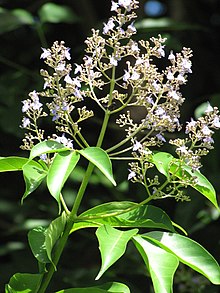Vitex parviflora
| Vitex parviflora | |
|---|---|

| |
| Scientific classification | |
| Kingdom: | Plantae |
| Clade: | Tracheophytes |
| Clade: | Angiosperms |
| Clade: | Eudicots |
| Clade: | Asterids |
| Order: | Lamiales |
| Family: | Lamiaceae |
| Genus: | Vitex |
| Species: | V. parviflora
|
| Binomial name | |
| Vitex parviflora | |
Vitex parviflora
It is a native species in Indonesia, Malaysia, and the Philippines.[8] It can also be found in Central and South America, the Caribbean, Oceania, and Asia.[8] It was reported to be an invasive species in Guam and Hawaii after it became naturalized in O’ahu and escaped from cultivation in Guam.[8] In Cuba, it is also considered as a possibly invasive species due to naturalization.[8]
It is valued in the Philippines for its dense durable wood and was once used extensively in furniture, boats, utensils, and as construction material.
References
- ^ . Retrieved 15 November 2021.
- ^ "Molave". OneToTree. Retrieved 2021-12-03.
- ^ USDA, NRCS (n.d.). "Vitex parviflora". The PLANTS Database (plants.usda.gov). Greensboro, North Carolina: National Plant Data Team. Retrieved 6 August 2015.
- ^ "molave". Merriam-Webster.com Dictionary. Retrieved 2022-09-23.
- ^ Bulletin. Bureau of Public Printing. 1907.
- ^ Merrill, Elmer Drew (1903). A dictionary of the plant names of the Philippine Islands. Manila: Bureau of Public Printing, Department of The Interior. p. 191 – via University of Michigan Digital Collections.
- ^ Bareja, Ben G. "Two Strains of Molave Tree Distinguished". Cropsreview.com. Retrieved 14 August 2017.
- ^ a b c d "Vitex parviflora (molave)". www.cabi.org. Retrieved 2022-09-23.
- .
- ^ Alvina, Corazon S. (2020-04-12). "The Hardwoods of our Vanishing Forests". Herald Suites. Retrieved 2022-09-23.
- ^ "PHILIPPINE ENVIRONMENT LAWS - CHAN ROBLES VIRTUAL LAW LIBRARY - FULL TEXT OF ACT NO. 3572". www.chanrobles.com. Retrieved 2022-09-23.
- ^ "Threatened plants of the Philippines: a preliminary assessment" (PDF). National Red List. p. 28. Retrieved 2022-09-23.
- S2CID 236273177.
- ^ "Molave". The Return of the Philippine Native Trees. Rain Forest Restoration Initiative. Retrieved 14 August 2017.
- ^ Bareja, Ben G. "The Molave Trees are Amazing, What With Their Plenty of Conventional Uses and New Ones That Evolved". Cropsreview.com. Retrieved 14 August 2017.
External links
- Wood Species and their Botanical Names in Alphabetical Order - (Molave is listed here.)

